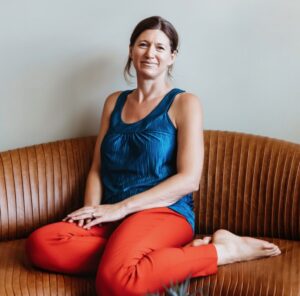This post is part-two of a series on therapeutic yoga for chronic pain. Part-one provided the science behind the mind-body-pain connection and explored the role of the brain in pain, how trauma exacerbates chronic pain, and why we need to move to heal. In this post, I apply the principles of therapeutic yoga to working with chronic pain conditions such as fibromyalgia, migraines, or back pain.
Yoga is a comprehensive and holistic approach to healing mind and body that involves meditation, breath awareness, spiritual inquiry, and living an ethical life. The word yoga is translated as “union” or to join together the mind and body through disciplined self-awareness. In most yoga classes, a teacher guides you to move with the breath, to focus your mind in the moment, and to cultivate a sense of curiosity about yourself. Within therapeutic yoga, personal inquiry becomes your greatest teacher. There is a decreased emphasis on the directives of an outer teacher guiding the outer shape of a posture and an increased focus on sensory awareness guiding intuitive, healing movements.
“Chronic pain experiences are often debilitating and can be life changing. It is common to feel powerless and overwhelmed. It is important to have predictable practices that offer relief for body, mind, and spirit. The principles of therapeutic yoga for chronic pain provide you with guidelines for your practice.”
-Dr. Arielle Schwartz
It is important to approach yoga carefully and listen to your body to avoid creating overwhelm or exacerbating chronic pain conditions. In other words, we need to pace ourselves when reclaiming the body from chronic pain conditions. Over time you can reclaim a sense of safety in your body and increase your ability to feel. Maybe you sense tightness in your hips or tension in your chest. Once you feel your sensations you can then use tools of breath and movement to work with your pain—instead of against it. You might notice that vulnerable emotions arise. When the time is right, allow yourself to release and let go as part of your healing.
Consider these principles of therapeutic yoga for chronic pain when looking for the right class or when developing a home-based practice:

Move, breathe, stretch, contract, and release.
Hopefully, by now you understand why I have not directed you into a specific sequence of physical yoga postures that will heal your fibromyalgia, chronic migraines, or back pain. Instead, I hope that I have inspired you to trust yourself and your body. Your sensations are your teacher—your yoga.
(photo credits: Victor Tondee, Creative Commons)

This post has excerpts from the book, Therapeutic Yoga for Trauma Recovery,
This book introduces you to the power of the yogic philosophy and offers a variety of accessible yoga poses and breathing practices that will allow you to:

Arielle Schwartz, PhD, is a psychologist, internationally sought-out teacher, yoga instructor, and leading voice in the healing of PTSD and complex trauma. She is the author of five books, including The Complex PTSD Workbook, EMDR Therapy and Somatic Psychology, and The Post Traumatic Growth Guidebook.
Dr. Schwartz is an accomplished teacher who guides therapists in the application of EMDR, somatic psychology, parts work therapy, and mindfulness-based interventions for the treatment of trauma and complex PTSD. She guides you through a personal journey of healing in her Sounds True audio program, Trauma Recovery.
She has a depth of understanding, passion, kindness, compassion, joy, and a succinct way of speaking about very complex topics. She is the founder of the Center for Resilience Informed Therapy in Boulder, Colorado where she maintains a private practice providing psychotherapy, supervision, and consultation. Dr. Schwartz believes that that the journey of trauma recovery is an awakening of the spiritual heart.

Arielle Schwartz, PhD, is a psychologist, internationally sought-out teacher, yoga instructor, and leading voice in the healing of PTSD and complex trauma. She is the author of five books, including The Complex PTSD Workbook, EMDR Therapy and Somatic Psychology, and The Post Traumatic Growth Guidebook.
Dr. Schwartz is an accomplished teacher who guides therapists in the application of EMDR, somatic psychology, parts work therapy, and mindfulness-based interventions for the treatment of trauma and complex PTSD. She guides you through a personal journey of healing in her Sounds True audio program, Trauma Recovery.
She has a depth of understanding, passion, kindness, compassion, joy, and a succinct way of speaking about very complex topics. She is the founder of the Center for Resilience Informed Therapy in Boulder, Colorado where she maintains a private practice providing psychotherapy, supervision, and consultation. Dr. Schwartz believes that that the journey of trauma recovery is an awakening of the spiritual heart.